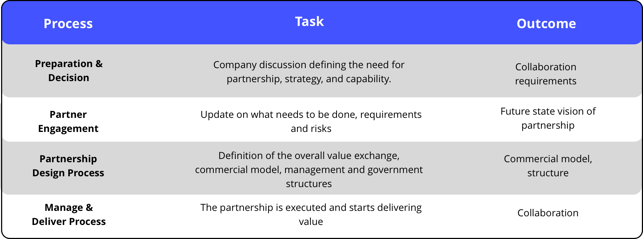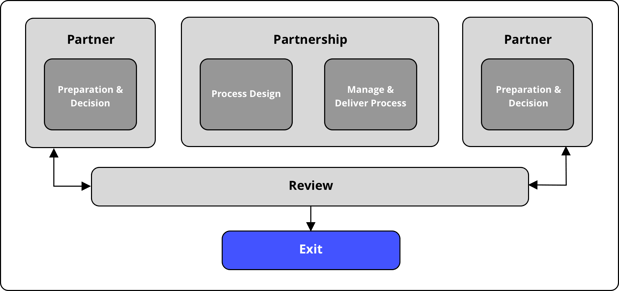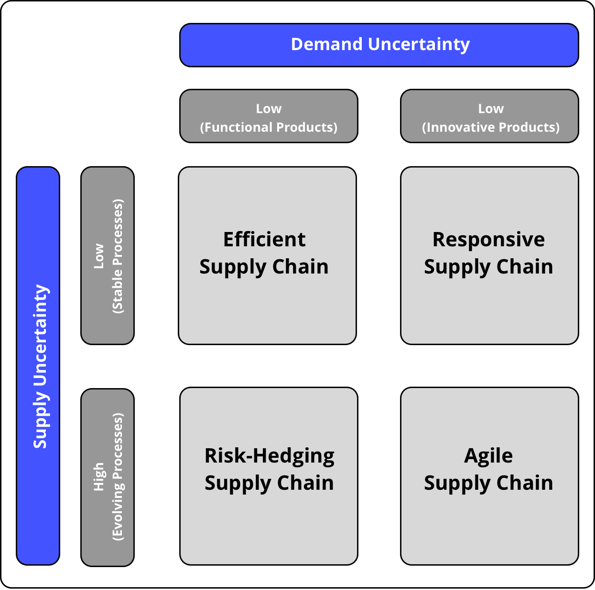Written by Dr. Rolf Neise, Senior Lecturer at the International School of Management (ISM) and business consultant, former Global Head of Logistics Operations at BAT.
To read the first article, click here.
In the first part of this series, the focus was on the organizational adaption required to develop a trustful and long-lasting collaboration between trading partners. This second part deals with the question of how B2B processes should be developed in partnership and how internal processes should be changed to use the available technology solutions successfully.
1. The overarching process for B2B – partnerships
If multiple companies are aiming for collaboration and wish to implement corresponding tools, they should follow a structured process. The expected outcome can only be reached if sufficient effort and commitment from all involved partners is given. The more structure there is behind this process, the better it works.
A four-stage process to start a collaboration and to establish long-lasting relationships is recommended here:

The following overarching process has proved itself in practice. It is based on learnings and on several experiences the author[i] collected in relationship building activities (see also Picture 1).
 Picture 1: The overarching process of Business Collaboration
Picture 1: The overarching process of Business Collaboration
2. The Preparation & Decision process
The preparation & decision process is the initiation process of all B2B cooperation’s. It has to be carried out by each partner individually. The single partner of the partnership should here be clarifying his internal strategy, understand the value proposition of the collaboration and select those partners he is aiming to cooperate with.
The partner should also be able to review his participation in the partnership at any given time and, if necessary, exit the partnership.
At first, it must be clarified if the company’s strategy is aiming for collaboration and whether they want to cooperate more closely with their partners. In designing their B2B integration strategy, companies need to answer the following key questions:
1. Where is the potential value for the company?
The discussion in the past was mainly about whether B2B solutions will provide value for the company. This value can be created from reduced transaction charges, from market efficiencies through reduced prices or from a better match of supply and demand, or general supply chain benefits. The company must identify the magnitude of these opportunities.
It is absolutely necessary to have this discussion to understand the value and the magnitude of these opportunities to extend business options and to decide about a relationship. But with nowadays available IT solutions companies have to think one step further.
By collecting and using the data collaboration platforms provide, companies are enabled to build data businesses. When collaborating with new business partners, companies can form new data ecosystems. These ecosystems give their participants access to valuable collective data assets as well as the capabilities and domain expertise necessary to develop the assets into new data-driven products and services. Companies that secure advantaged positions in data ecosystems will generate significant value and competitive advantage across their entire business, including their traditional hardware offerings. The data and the analytics can also be used as the starting point of the data-driven supply chain.
2. What are the key success factors to extract value?
In this step, the company must determine whether it possesses the key success factors required to extract the potential value identified. These success factors can be classified as the business model, IT requirements, and organizational requirements. The goal is to identify both the elements already in place, and those that need to be implemented before value can be extracted.
The organizational requirements defining the governance, the ways of working and the incentives needed to extract value from a B2B partnership are explained in the first article.
The Business Model
The business model should be based on the supply chain strategy which defines the nature of supply chain relationships with various suppliers, customers, and other trading partners like service providers or authorities. Related to supply and demand uncertainty, four general types of supply chains exist (see Picture 2). Of primary goals are that supply chains would be efficient and responsive.

Picture 2: Different Supply Chain strategies based on Demand and Supply uncertainty
A company focused on efficiency will benefit from reducing transaction charges. A company focused on responsiveness, however, may not necessarily benefit from reducing transaction charges if the result is diminished responsiveness. In fact, targeting reduced transaction charges may have a significant negative impact on supply chain relationships. If these relationships are vital to providing responsiveness, companies will probably not want to pursue transaction charge reductions.
Market efficiencies through improved matching of surplus supply and unmet demand can benefit all partners in the supply chain. Faster reaction time and more reliable delivery time is also in the interest of all partners as well as improved data quality.
Regardless of whether they are pursuing efficiency or responsiveness strategy, all companies can extract supply chain benefits through B2B cooperation. The key is to collaborate in a way that benefits all partners. Effective collaboration reduces total costs rather than redistributing them. A B2B platform facilitates collaborative activities and enhances the opportunities that collaboration provides.
IT Requirements
Information technology requirements define the technical capabilities that must be in place for a company to transfer its business processes to a B2B – platform in a sustainable way. Companies need to ask the following questions when analyzing IT requirements:
- What are the business processes and systems that will be transformed or integrated into a B2B platform?
- What will it take to transform or integrate these systems (time and costs)?
- Can the current level of IT skills and infrastructure support the transformation?
IT requirements for reducing transaction charges focus on simplifying the tasks of order placement, fulfillment and tracking by integrating systems for pricing, product availability, and ordering across different channels (e.g., catalogues, web, and sales force). Suppliers, transportation providers, warehouses, and buyers also must have systems that centrally and dynamically provide pricing, quotation, ordering, availability, and tracking.
Price reductions through market efficiencies require information technology that provides an information infrastructure such that product specifications can be clearly conveyed to and from potential suppliers and supplier bids can be received and evaluated.
Matching surplus supply with unmet demand requires information technology that provides visibility into available supply as well as into demand across the supply chain.
Effective collaboration can only occur if all collaborating partners can easily access all supply and demand data. Another key IT requirement is a detailed set of data standards for the online identification of goods, orders, and shipments. At present, industrywide standards are incomplete, and many individual companies are using their own standards for limited collaborative activities.
3. With which partner does the company want to cooperate?
If a B2B set-up provides value for the company, potential partners must be selected. These can either be customers, suppliers, and other trading partners like authorities or even competitors. The selection should be based on the magnitude of these opportunities and the willingness and capability of the other party to cooperate.
It is essential to understand the partners’ needs and values, his business model, and its underlying processes. For a sustainable collaboration, precise delivery and feedback mechanisms have to be defined and agreed. In deciding on business partners, it is important to make sure that both parties' business models are complementary.
Finally, a risk assessment covering all potential eventualities should be conducted to understand the impact of such a partnership fully.
4. What are the current market options?
The last critical activity is to analyze the market options for implementing B2B e-commerce operations. Companies must be aware of the available technology today. With the development of B2B integration platforms, a true paradigm shift in B2B collaboration took place. These platforms help companies to integrate all their complex processes across their partner communities in a single gateway. They also automate B2B processes across companies while providing governance, adherence to standards and full visibility. Instead of using traditional integration software or even hand-coding all integrations, these platforms deliver much faster solutions at significantly lower costs.
3. Partner Engagement
If all questions are answered satisfactorily and if the value of B2B cooperation for the company is visible and if the partners are selected, the collaboration should start by engaging with the potential partners. This is the stage at which it is important to have an internal governance structure in place. A manager should be appointed to make decisions and to act as an escalation point for the team.
The potential partner company must be updated on the targets of such a relationship, what needs to be done to adapt the internal processes and to design the B2B processes. Potential risks should also be evaluated as well as the value sharing model.
The outcome of this phase should be, beside the decision to proceed, a future state vision for which the partnership should be aiming for as well as an agreement about the required governance and organization (Article 1). In further detailing, the vision of a collaborative business model between the partners should be developed.
4. The B2B design process
If the partners agree to carry on, a detailed B2B design planning process starts. It includes planning exactly how the value exchange will take place between the partners and be delivered. It is important to design a flexible structure, which could change with the markets, feedback, and changing requirements, rather than a fixed value exchange which would be difficult to influence.
A conceptual framework is proposed here which consists of the definition of the following: business requirements, a business solution, an IT architecture solution, and a technological solution (see Picture 3). This whole process can be simplified by using B2B integrator platforms. Nevertheless, it is essential to identify the exact business requirements.
 Picture 3: Framework for the development of B2B collaboration
Picture 3: Framework for the development of B2B collaboration
4.1 Business Requirements
The identification of the business requirements of a B2B collaboration derives from the collaborative business model that partners agree to carry out. Such requirements refer to the common goals to be achieved, the roles the involved partners fulfil, as well as the identification of the collaborative business processes to be carried out. It also includes the communication relationships, the cooperative agreement parameters, and the hierarchy of common business goals to be fulfilled by partners. This exercise is jointly carried out by partner companies. If the business requirements are defined and agreed, the solution can be prepared to consist of the business solution and the IT architecture.
4.2 Business Solution
The business solution consists of defining how partners will manage the B2B collaboration. This implies the definition of the explicit behavior of collaborative business processes (CBPs) from a business viewpoint, which describes the global view of the interactions between partners. The business solution also implies the definition of the business processes that each partner has to make to support CBPs. Thus, it is necessary to define the interface and integration of business processes of each partner, which describe the behavior of the role the partner performs in CBPs.
This solution is defined by business analysts and system designers who are responsible for establishing the business aspects of the B2B collaboration. All these business processes should be defined in a platform independent way, and they differ in their viewpoint and the detail level in which they are expressed.
4.3 IT Architecture Solution
The IT architecture solution consists in defining the systems’ architecture that each partner has to implement to support the business processes defined in the business solution. This is achieved by applying a system architecture paradigm to describe the software architecture of the systems that each partner has to implement. The design of the IT architecture is accomplished at a platform-independent abstraction level.
4.4 Technological Solution
If the architecture solution is approved, the implementation of the solution can begin. The implementation of the technological solution consists of the specifications of business processes and system interfaces by using B2B standards or technologies, in such a way that the partners’ systems can interoperate and support the execution of CBPs. The technological solution is implemented by IT developers using platform-specific concepts to generate executable code of the B2B specifications.
5. The Manage & Deliver Process
After a successful design phase, the execution starts with the manage and deliver processes. There might be an in-between phase, in which the delivery may be tested and the outcome reviewed. The organizational structure should be fully in place, the performance of the collaboration should be measured regularly and commonly reviewed. Throughout the delivery phase, learnings arise on how to do things more effectively. Changes to the processes or the structure must be implemented accordingly.
Conclusion
The shape of business is changing – driven by digitization – to an environment where all companies are more reliant on their relationship with their trading partners. Modern supply chains are becoming digital ecosystems facilitating closer collaboration and new joint work practices.
We are phasing a paradigm shift in B2B collaboration visible today, due to the availability of cloud computing and SaaS options, big data analytics and the need of supply chains to be faster, more agile and more reliable than ever.
Companies are rethinking critical aspects of multi-enterprise process collaboration and the underlying technology that drives it. They are turning to solutions that deliver the speed, agility, high-availability, and resilience necessary to offer the performance demanded by today’s economy. In fact, the most progressive companies around the world are taking the position that the underlying technology driving multi-enterprise process collaboration can and should be a competitive differentiator and not just viewed as IT infrastructure.
In this two-part series, the questions of how an organization must be adapted and how processes should be changed to use nowadays available IT systems integration solutions were discussed successfully. If companies establish open-minded cooperation based on trust and shared values, a continuous improvement culture, and a farsighted governance structure, they will see immediate and long-term results in any collaboration effort.
If in addition, the process adaption follows a structured process considering the main highlighted elements to put in place the proper foundation for this new era of B2B collaboration, the desired outcome will most properly exceed expectations. These two factors, the adapted organization, and the revised processes will truly open the door for new opportunities in collaboration and beyond. It only should be ensured that the right companies are working together to deploy solutions that will deliver all the requirements that today’s economy is demanding.
References
Neise, R. (2018): Container Logistics - The Role of the Container in the Supply Chain; pp 393 – 396, Kogan Page, London.
Russo, M.; Albert, M.: How IoT Data Ecosystems Will Transform B2B Competition; Boston Consulting Group, 2019.
Hummel, E., G. Slowinski, S. Matthews, and E. Gilmont. 2010. Business models for collaborative research. Research Technology Management 53 (6) 51-54.
Lazarte, M.; Tello-Leal, E.; Roa, J.: Model-Driven Development Methodology for B2B Collaborations; Conference Paper· November 2010.
IBM: Are You Ready For a New Era in B2B Collaboration?; IBM Corporation 2016, New York 2016.

